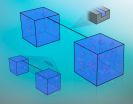University of Minnesota engineers make sound loud enough to bend light on a computer chip
Device could improve wireless communications systems
2014-11-26
(Press-News.org) MINNEAPOLIS / ST. PAUL (11/26/2014)--During a thunderstorm, we all know that it is common to hear thunder after we see the lightning. That's because sound travels much slower (768 miles per hour) than light (670,000,000 miles per hour).
Now, University of Minnesota engineering researchers have developed a chip on which both sound wave and light wave are generated and confined together so that the sound can very efficiently control the light. The novel device platform could improve wireless communications systems using optical fibers and ultimately be used for computation using quantum physics.
The research was recently published in Nature Communications, a leading research journal.
The University of Minnesota chip is made with a silicon base coated with a layer of aluminum nitride that conducts an electric change. Applying alternating electrical signal to the material causes the material to deform periodically and generate sound waves that grow on its surface, similar to earthquake waves that grow from the center of the earthquake. The technology has been widely used in cell phones and other wireless devices as microwave filters.
"Our breakthrough is to integrate optical circuits in the same layer of material with acoustic devices in order to attain extreme strong interaction between light and sound waves," said Mo Li, assistant professor in the Department of Electrical and Computer Engineering and the lead researcher of the study.
The researchers used the state-of-the-art nanofabrication technology to make arrays of electrodes with a width of only 100 nanometers (0.00001 centimeters) to excite sound waves at an unprecedented high frequency that is higher than 10 GHz, the frequency used for satellite communications.
"What's remarkable is that at this high frequency, the wavelength of the sound is even shorter than the wavelength of light. This is achieved for the first time on a chip," said Semere Tadesse, a graduate student in the University of Minnesota's School of Physics and Astronomy and the first author of the paper. "In this unprecedented regime, sound can interact with light most efficiently to achieve high-speed modulation."
In addition to applications in communications, researchers are pursuing quantum physics applications for the novel device. They are investigating the interaction between single photons (the fundamental quantum unit of light) and single phonons (the fundamental quantum unit of sound). The researcher plan to use sound waves as the information carriers for quantum computing.
INFORMATION:
The research is funded by National Science Foundation and Air Force Office of Scientific Research. The device was fabricated in the cleanroom at the Minnesota Nano Center at the University of Minnesota.
To read the full article, entitled "Sub-optical wavelength acoustic wave modulation of integrated photonic resonators at microwave frequencies," visit the Nature Communications website.
[Attachments] See images for this press release:

ELSE PRESS RELEASES FROM THIS DATE:
2014-11-26
In recent years it has been established that copper plays an essential role in the health of the human brain. Improper copper oxidation has been linked to several neurological disorders including Alzheimer's, Parkinson's, Menkes' and Wilson's. Copper has also been identified as a critical ingredient in the enzymes that activate the brain's neurotransmitters in response to stimuli. Now a new study by researchers with the U.S. Department of Energy (DOE)'s Lawrence Berkeley National Laboratory (Berkeley Lab) has shown that proper copper levels are also essential to the health ...
2014-11-26
Lincoln, Neb., Nov. 26, 2014 -- By solving a six-dimensional equation that had previously stymied researchers, University of Nebraska-Lincoln physicists have pinpointed the characteristics of a laser pulse that yields electron behavior they can predict and essentially control.
It's long been known that laser pulses of sufficient intensity can produce enough energy to eject electrons from their ultrafast orbits around an atom, causing ionization.
An international team led by the UNL researchers has demonstrated that the angles at which two electrons launch from a helium ...
2014-11-26
The Tropical Rainfall Measuring Mission or TRMM satellite provided rainfall data as Tropical Depression 21W was making landfall in the southern Philippines on Nov. 26.
TRMM revealed areas of heavy rainfall in fragmented bands east of the center of circulation, where rain was falling at more than 1 inch (25 mm) per hour. TRMM rainfall data was overlaid on infrared data from the Japan Meteorological Agency's MTSAT-1 satellite that showed Tropical Depression 21W's (TD21W) clouds extended from western Mindanao, east into the Philippine Sea.
On Nov. 26, there were a number ...
2014-11-26
ST. LOUIS-- In research published in the medical journal Brain, Saint Louis University researcher Daniela Salvemini, Ph.D. and colleagues within SLU, the National Institutes of Health (NIH) and other academic institutions have discovered a way to block a pain pathway in animal models of chronic neuropathic pain including pain caused by chemotherapeutic agents and bone cancer pain suggesting a promising new approach to pain relief.
The scientific efforts led by Salvemini, who is professor of pharmacological and physiological sciences at SLU, demonstrated that turning on ...
2014-11-26
Hamilton, ON (Nov. 26, 2014) - McMaster University researchers have found that current evidence does not support the routine use of minimally invasive surgery to remove herniated disc material pressing on the nerve root or spinal cord in the neck or lower back.
In comparing it with open surgery, they found that while minimally invasive surgery for cervical or lumbar discectomy may speed up recovery and reduce post-operative pain, it does not improve long-term function or reduce long-term extremity pain.
Minimally invasive surgery for discectomy also requires advanced ...
2014-11-26
This news release is available in German. The human brain continuously collects information. However, we have only basic knowledge of how new experiences are converted into lasting memories. Now, an international team led by researchers of the University of Magdeburg and the German Center for Neurodegenerative Diseases (DZNE) has successfully determined the location, where memories are generated with a level of precision never achieved before. The team was able to pinpoint this location down to specific circuits of the human brain. To this end the scientists used a ...
2014-11-26
The evolution of freshwater shrimps species living in both sides of Central America, isolated by the closure of Isthmus of Panama (3 million years ago) were studied by molecular tools. Despite the small likelihood of species crossing the Isthmus from one side to the other through the channel exist, the genetic isolation of them were maintained over the time and the separation of Pacific and Atlantic sister species still unchanged. Sister species refer to pairs of species that are genetically and morphologically closely related, but reproductively isolated.
The collection ...
2014-11-26
A new paper, by Dr Stanley Blue, lecturer in Social Sciences at The University of Manchester, claims that there needs to be a shift in public health policy, with less focus on efforts to change individual behaviour and more attention on breaking social habits and practices that are blindly leading us into bad health.
Theories of practice and public health: understanding (un)healthy practices is published in the journal, Critical Public Health, and written by Dr Stanley Blue, lecturer at the School of Social Sciences, Prof Elizabeth Shove, of Lancaster University, Prof ...
2014-11-26
CLEVELAND, Ohio (November 26, 2014)--Removing ovaries at hysterectomy does not increase a woman's risk of pelvic organ prolapse after menopause. In fact, removing ovaries lowers the risk of prolapse. This surprising finding from a Women's Health Initiative study was published online this week in Menopause, the journal of The North American Menopause Society (NAMS).
Whether to remove ovaries at hysterectomy for reasons other than cancer is a subject of hot debate. Removing them reduces the risk of breast cancer and dramatically reduces the risk of ovarian cancer. On the ...
2014-11-26
For several years, it has been known that superfluid helium housed in reservoirs located next to each other acts collectively, even when the channels connecting the reservoirs are too narrow and too long to allow for substantial flow. A new theoretical model reveals that the phenomenon of mysterious communication "at a distance" between fluid reservoirs is much more common than previously thought.
Liquids in containers that are at a distance from each other may behave collectively, even if the channels connecting the reservoirs are so narrow and long that they prevent ...
LAST 30 PRESS RELEASES:
[Press-News.org] University of Minnesota engineers make sound loud enough to bend light on a computer chip
Device could improve wireless communications systems




